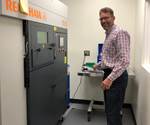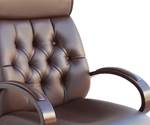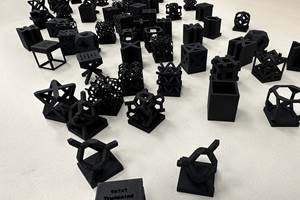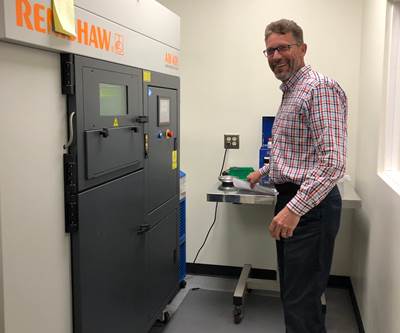AM’s 2020 Advance: How the Crisis Created Conditions for Additive Manufacturing to Leap Ahead
Stories we’ve found within the pandemic period reveal 3D printing’s promise for scalable, flexible production and rapid product development.
Additive manufacturing (AM) is a disruptive technology. What that means is: It changes the rules of the very system to which it’s applied. It is not a plug-in solution that cleanly replaces conventional modes of production. Instead, it represents an entirely different way of thinking about not just manufacturing, but also manufacturing’s relationship to design as well as to the entire enterprise around it. That extent of disruption is what makes AM difficult to implement within an organization already committed to conventional production.
But when the times are disrupted for an altogether different reason, a disruptive technology can more easily deliver its promise and move ahead.
The Cool Parts Show is Additive Manufacturing’s video series for showcasing success stories with 3D printing for end-use parts During the lockdown period of the coronavirus pandemic, we thought we would take a break from producing the show. In conversations with AM users, however, we discovered that AM was not taking a break. Stories of 3D printing delivering personal protective equipment (PPE) were widespread, but perhaps more telling for the long-term role of AM, we also found stories of additive leaping ahead to deliver on some of its more ambitious promises related to the scalability of production and the speed of product development.
Embedded below are episodes of The Cool Parts Show that tell the stories of the wins in these areas — wins that all happened while many of us were sheltering at home.
During a time of disruption, additive manufacturing was used to achieve all of this:
1. Scaled-Up Production: Test Swabs by the Millions and Immediate Reshoring of Swabs Manufacturing
3D printing of nasopharyngeal test swabs used to detect COVID-19 created the capacity to make these swabs in the U.S. at the rate of millions per week, almost immediately ending the reliance on foreign manufacturing for these swabs. Importantly, no swabs 3D printing factory will perform this production, because 3D printing allows manufacturing to be distributed among many sources. Watch the episode:
2. Rapid Product Development: New Product for New Market Goes from Idea to Production in 10 Days
Fitz Frames uses 3D printing to make custom eyeglasses. The coronavirus created a need for eyeglasses as PPE because wearing contact lenses is problematic for healthcare workers battling the crisis. However, PPE eyewear has different requirements from day-to-day eyewear. Because 3D printing was the manufacturing method, the Fitz team was able to innovate and iterate so quickly that the new product was ready for production in 10 days. To support care workers, Fitz is donating many of these glasses. Watch the episode:
3. Scaled-Up Production: Implant Maker Meets Surging Demand
Tangible Solutions is a company founded to make medical implants through 3D printing. The value of this mode of manufacturing was revealed during the pandemic. Implant demand surged, because medical providers were stocking up to get ready for the coming demand in implant replacements due to the surgeries being delayed. The additive capacity was scalable to meet the sudden increase. Conventional operations, specifically machining, posed the limitation that had to be addressed. Watch the episode:
4. Rapid Product Development: 13 Parts Replaced by 1
The interruption of normal production left drone engine maker Cobra Aero with little to do but re-evaluate its product. The company already used AM, recognizing this as a better way to produce engine cylinders. What the company did not see was the even bigger win for AM just waiting to be found: the exhaust system. By exploring and iterating during the break, Cobra’s engineering team developed a new exhaust system that is lighter, cheaper, better-performing and easier to produce. Replacing 13 parts with a single 3D printed component will now drastically reduce assembly work. Watch the episode:
Related Content
3D Printed "Evolved Structures" for NASA Exoplanet Balloon Mission: The Cool Parts Show #61
Generative design creates stiff, lightweight brackets for EXCITE mission monitoring planets orbiting other stars. The Cool Parts Show visits Goddard Space Flight Center.
Read MoreVixiv Developing AI Alternative to Generative Design
Newly opened Ohio facility is where geometric cells are made and tested to inform the machine learning system that will “know,” without computation, what 3D printed form satisfies a given set of needs.
Read MoreImplicit Modeling for Additive Manufacturing
Some software tools now use this modeling strategy as opposed to explicit methods of representing geometry. Here’s how it works, and why it matters for additive manufacturing.
Read More3D Printed Cutting Tool for Large Transmission Part: The Cool Parts Show Bonus
A boring tool that was once 30 kg challenged the performance of the machining center using it. The replacement tool is 11.5 kg, and more efficient as well, thanks to generative design.
Read MoreRead Next
Drone Engine Maker Illustrates How Additive Manufacturing Well Suited to OEMs
This small company making small engines sees big wins from metal AM in terms of both product performance and responsiveness to the market. Here, size isn’t a factor in succeeding with AM — the application instead shows how the capability is at its best when it can serve both production and design.
Read MoreThe Cool Parts Show Season 2 Out Now
Season 2 covers cool 3D printed parts from a major automaker, a custom glasses company, a drone engine manufacturer, a dental lab and a research organization.
Read MoreWhat Your CEO Needs to Know About Additive Manufacturing
Additive manufacturing promises to affect far more than manufacturing alone. When evaluating AM, the perspective needed is the view that sees the impacts all across the enterprise.
Read More




















